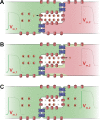Mechanisms of cardiac conduction: a history of revisions
- PMID: 24414064
- PMCID: PMC3949060
- DOI: 10.1152/ajpheart.00760.2013
Mechanisms of cardiac conduction: a history of revisions
Abstract
Cardiac conduction is the process by which electrical excitation spreads through the heart, triggering individual myocytes to contract in synchrony. Defects in conduction disrupt synchronous activation and are associated with life-threatening arrhythmias in many pathologies. Therefore, it is scarcely surprising that this phenomenon continues to be the subject of active scientific inquiry. Here we provide a brief review of how the conceptual understanding of conduction has evolved over the last century and highlight recent, potentially paradigm-shifting developments.
Keywords: cardiac conduction; ephaptic coupling; gap junctions; modeling; myocardium.
Figures

References
-
- Agullo-Pascual E, Lin X, Pfenniger A, Lubkemeier I, Willecke K, Rothenberg E, Delmar M. A novel noncanonical role of cx43 in the heart: ensuring the arrival of nav1.5 to the intercalated disk. Heart Rhythm 10: 1742, 2013
-
- Akar FG, Nass RD, Hahn S, Cingolani E, Shah M, Hesketh GG, DiSilvestre D, Tunin RS, Kass DA, Tomaselli GF. Dynamic changes in conduction velocity and gap junction properties during development of pacing-induced heart failure. Am J Physiol Heart Circ Physiol 293: H1223–H1230, 2007 - PubMed
-
- Angst BD, Khan LU, Severs NJ, Whitely K, Rothery S, Thompson RP, Magee AI, Gourdie RG. Dissociated spatial patterning of gap junctions and cell adhesion junctions during postnatal differentiation of ventricular myocardium. Circ Res 80: 88–94, 1997 - PubMed
-
- Axelsen LN, Stahlhut M, Mohammed S, Larsen BD, Nielsen MS, Holstein-Rathlou NH, Andersen S, Jensen ON, Hennan JK, Kjolbye AL. Identification of ischemia-regulated phosphorylation sites in connexin43: a possible target for the antiarrhythmic peptide analogue rotigaptide (ZP123). J Mol Cell Cardiol 40: 790–798, 2006 - PubMed
Publication types
MeSH terms
Grants and funding
LinkOut - more resources
Full Text Sources
Other Literature Sources
Miscellaneous

